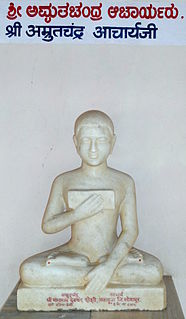This article is being considered for deletion in accordance with Wikipedia's deletion policy. Please share your thoughts on the matter at this article's entry on the Articles for deletion page. Feel free to improve the article, but the article must not be blanked, and this notice must not be removed, until the discussion is closed. For more information, particularly on merging or moving the article during the discussion, read the guide to deletion. |
This article has multiple issues. Please help improve it or discuss these issues on the talk page . (Learn how and when to remove these template messages)
(Learn how and when to remove this template message) Contents |
| Pranamyasagar | |
|---|---|
Muni Pranamya sagar in Rohini, New Delhi | |
| Religion | Jainism |
| Works | Tithiyar Bhāvna (Prakrit), Upyog-Shatkam |
| Initiation | by Acharya Vidyasagar |
| Part of a series on |
| Jainism |
|---|
 |
Jain prayers |
Ethics |
Major sects |
Festivals |
Muni Pranamya sagar, is a Digambara monk and a disciple of Acharya Vidyasagar. Author of several literary works, he is best known for preaching arham yog. He is also known for writing the first commentary on Āchārya Kundakunda’s Baras Anuvekkha, a 2000 yr old Jain text.

Digambara monk is a monk in the Digambara tradition of Jainism, and as such an occupant of the highest limb of the four-fold sangha. They are also called nirgrantha which means "one without any bonds". Digambara monks have 28 primary attributes which includes observance of the five supreme vows of ahimsa (non-injury), truth, non-thieving, celibacy and non-possession. A Digambara monk is allowed to keep only a feather whisk, a water gourd and scripture with him.

Acharya Shri Vidyasagarji Maharaj is one of the best known modern Digambara Jain Acharya. He is known both for his scholarship and tapasya (austerity). He is known for his long hours in meditation. While he was born in Karnataka and took diksha in Rajasthan, he generally spends much of his time in the Bundelkhand region where he is credited with having caused a revival in educational and religious activities.

Acharya Kundakunda was a Digambara Jain monk and philosopher, who is still revered. He authored many Jain texts such as: Samayasara, Niyamasara, Pancastikayasara, Pravachanasara, Atthapahuda and Barasanuvekkha. He occupies the highest place in the tradition of the Digambara Jain acharyas, a position comparable to Christ in Christianity. All Digambara Jains say his name before starting to read the scripture. Modern scholarship has found it difficult to locate him chronologically, with a possible low date in the 2nd-3rd centuries CE and a late date in 8th century.





